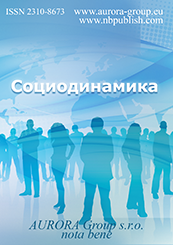Social studies and monitoring
Reference:
Goltcova, E. (2016). Research of the socio-environmental determination of migration behavior of the youth in Irkutsk Oblast. Sociodynamics, 12, 110. https://doi.org/10.7256/2409-7144.2016.12.2125
Abstract:
The object of this research is the migration behavior of youth, while the subject is the specificity of formation of migration behavior among the young people in Irkutsk Oblast. We can observe various manifestations of migration behavior among this age group, which can consist in a high motivation towards migration, or a complete rejection thereof. The author thoroughly examines the socio-environmental factors of determination of the migration behavior, as well as defines the level of their impact upon the establishment of migration trends. In the last decades, there is a large youth migration outflow from Irkutsk Oblast. The study aimed at revelation of the migration trends, demonstrated that the model of migration behavior among youth of Irkutsk Oblast forms under the direct influence of socio-environmental factors, as well as subjective characteristics of the respondents. The author analyzes the motivating and demotivating factors, and determines the correlations between external and internal factors of determination of the migration behavior.
Keywords:
Migration outflow, Human demands, Motivation, Youth , Irkutsk Oblast, Survey, Socio-environmental determinants, Social environment, Migration behavior, Migration
State and civil society
Reference:
Antropova, I., Korobeinikova, A.P. (2016). Nonprofit organizations and unformalized socially important activeness of the citizens (regional aspect). Sociodynamics, 12, 1118. https://doi.org/10.7256/2409-7144.2016.12.2085
Abstract:
This article analyzes such social phenomenon of the Russian reality as reconceptualization of the third sector, which currently is not limited by the institutionalized NPO’s, but rather represents a complicated system that also includes the unformalized socially important citizens’ activeness (individual and group initiatives, public participation, and other forms of citizens’ self-organization by their place of residence). The authors attempt to explain the established situation of shift of the center of gravity of socially important activeness of the citizens from the institutionalized forms towards unformalized institutions. The article contains the results of the conducted personal questionnaire of the Sverdlovsk Region population of two age groups (16-29 and 30+), as well as survey of the experts (state and municipal officials, heads of the NPO’s). The authors provide the assessment of the current status of socially oriented NPO’s in Sverdlovsk Region, conditions for functioning of the NPO in the region, as well as forecast of the prospects of development of the third sector. The work also reflects the main trends characterizing the readiness of the Sverdlovsk Region population regarding its participation in the activity of NPO and socially important practices.
Keywords:
reconceptualization, social practices, social activity, civic initiatives, self-organization of citizens, third sector, nonprofit organizations, civil society, informal associations, institutionalization
Questions of current interest
Reference:
Bagrova, E.V. (2016). The regularities of emergence and development of structural crises. Sociodynamics, 12, 1926. https://doi.org/10.7256/2409-7144.2016.12.2030
Abstract:
The subject of this article is the crucial regularities that are formulated by the philosophers and other scholars in the area of emergence and development of structural social crises, as well as a brief analysis of the commonness of the important crises in the history of humanity: collapse of the Roman Empire, Great Depression, and collapse of the Soviet Union – as the reflections of theoretical concepts. The goal of this research is the specificity of regularities of emergence and development of the structural social crises. The author particularly analyzes the works of Spengler, Toynbee, Toffler, Jaspers, Sorokin, Marx, Keynes, and other accomplished scholars. The acquired results are compared to the most significant social crisis in the history of humanity. For achieving of the set goal, the author analyzes the theoretical most important concepts in the field of crisis phenomena. The conclusion is made that different authors indicated various causes of the crisis phenomena; however, several key regularities can be determined. Particularly, excessiveness of any social processes, including economic and advancement of any technologies, as well as additional interconnections between different areas of social life that define their interdependence. In addition to that, one of the main reasons of crises consists in artificially created, as the result of social development, subordination of certain elements to others, which does not exist at essential level. The results acquired during the course of this research can be applied in social and humanitarian sciences for the better understanding of crisis phenomena, processes of their occurrence and development, as well as search for the ways to stabilize the social development.
Keywords:
anthropogenic crisis, reasons of the crisis phenomena, pattern of crisis development, pattern, crisis of overproduction, crisis, social development, structural crisis, collapse of the Roman Empire, Great Depression
Questions of current interest
Reference:
Smirnova, A., Aver'yanova, M. (2016). Peace museums as peacemaking actors: political and psychological aspects. Sociodynamics, 12, 2736. https://doi.org/10.7256/2409-7144.2016.12.2103
Abstract:
This article examines the peace museums – a distinct type of museums, which are dedicated to peace work and criticizing violence in all its forms. The relevance of this research is explained by the special role, which peace museums intend to play in social development and world politics. Although the number of peace museums is gradually growing, they remain on the periphery of peace studies, as well as unstudied within the framework of other disciplines. This article is aimed at the analysis of the concept of peace museums and characteristics of their psychological and political features. Peace museums are viewed as a complex phenomenon, which combines the areas of international, intrastate, intergroup and interpersonal relations. The object of this research is the role of peace museums in social development, while the subject is the political and psychological components of peace museums. The main method of this work is the critical analysis of scientific literature and information sources along with the political and psychological concepts for examining the specificity of the museums. Due to the fact that currently there is no single approach towards defining and characterizing the peace museums, the article suggest the narrow and broad interpretations of this notion, as well as provides the typology of the contemporary peace museums. In second part of the article, the authors review the questions of psychological effect from visiting such museums, as well as difficulties that emerge due to their political orientation. The specificity of peace museums consists in their orientation towards resolution of the conflicts and internationalism, however, the peculiarity of the subject and antagonism with the state ideology impede the prosperity of peace museums. In the authors' opinion, the study of peace museums can enrich our perception of the problems of peace and violence, as well as contribute into the development of social and humanitarian sciences.
Keywords:
peace movement, international relations, peace infrastructure, transformation of conflicts, museum psychology, peace studies, anti-war museums, peace museums, pacifism, internationalism
State and civil society
Reference:
Maslanov, E.V., Maslanov, D.V. (2016). Typology of projects in the field of political crowdsourcing in Russia. Sociodynamics, 12, 3746. https://doi.org/10.7256/2409-7144.2016.12.1949
Abstract:
This article gives special attention to the question of application of the new information and communication technologies in government administration. The author believe that the Internet became one of the key technologies that changed the “image” of society, ways of interaction between people, and mechanisms of distribution of information. In turn, the “Arab Spring” and other events demonstrated that Internet technologies actively and effectively are used in construction and management of the political changes. One of such technologies is the political crowdsourcing. The variety of projects that use crowdsourcing requires systematization and classification. Therefore, the author attempt to typologize the existing projects, and clarify how the different types of these projects affect the society and government authority. Referring to the political reality of modern Russia, the work analyzes and classifies the existing within the country projects. The scientific novelty lies in the fact that for the purpose of establishing the appropriate classification of the projects in the area of political crowdsourcing, the two main substantive criteria consisting of the organizer and goals of the projects, are being determined. Based on them, the authors formulate the typology, which includes four main groups with characteristic to each of them peculiarities. The development of each of these groups, in other words, increase or decrease in the amount of projects, intensity of implementation of the results of their work by the government bodies, can demonstrate the dynamics of development of interaction between the society and the government in Russia.
Keywords:
Public initiative, Authority, Internet, Political technology, Russia, Information and communication technologies, Political process, Crowdsourcing, Political system, Legitimacy
State and civil society
Reference:
Bogomolova, E.S. (2016). PR-communication as the form and method of managing social relations in the current realities. Theoretical substantiation of the essence of communicative theories of authority and PR in pragmatic aspect. Sociodynamics, 12, 4753. https://doi.org/10.7256/2409-7144.2016.12.1944
Abstract:
This article suggests examining the definition of PR-communication as the area of knowledge and sphere of activity in the political process. The role of communication approach in managing social relations by the government agencies is the key subject of this research. The author raises the issue of particular need of the state executive authority in the new forms and methods of interaction with the modern society. Trend towards the increase in demand regarding the answerability and transparency of the state apparatus in our county, in the author’s opinion, actualizes the application of communicative technologies in the work of PR-structures of the agencies of government administration. The research underlines the necessity in establishment of the bilateral model of political communication, the goal of which will become the search of compromises and strive for the achievement of social consensus. The author put PR-communication into direct dependence with the characteristics of viability of the government apparatus. The presence of communicative space between the authority and the citizens as a platform for legal confrontation of the interests and discussion between the parties will allow launching the process of quality reorganization of the system of social management.
Keywords:
Political discourse, Communicative space, Legitimacy, Social consensus, Political communication, Social communication, Political process, Public authority, Social relations, PR-communication
People and work
Reference:
Ivanov, S.Y., Ivanov, A.S., Morkovkin, D.E., Gumennaya, N.S. (2016). Professional trajectories of the university graduates and their labor adaptation. Sociodynamics, 12, 5467. https://doi.org/10.7256/2409-7144.2016.12.1937
Abstract:
This article examines certain questions associated with the professional career of university graduates. Under the conditions of dynamics of socio-economic processes, increases the role of professional and personal qualities that ensure competitiveness in the job market, as well as building a successful professional career. The employment of university graduates represents one of the key indicators in their demand, which captures the entire number of stages of the three-party interaction “university-employer-student”. In many ways, the competitive advantages of the graduates along with their personal expectations, define the opportunities for their successful employment. Based on the results of sociological survey, the authors determine the main professional trajectories of the young specialists, as well as the obstacles that impede their successful adaptation in the job market. The primary results of this research consist in revelation of the professional expectations of the young generation under the current conditions, and determination of the general professional skills that are mostly in demand among the young specialists. The authors signify the further career plans of the graduates, reveal the reasons of further specialization outside the core area, as well as possible ways to adjust the professional trajectories of young specialists.
Keywords:
career plans, job market, employment, labor adaptation, young professionals, graduates, youth, profession, career, employer
Conflict and consensus
Reference:
Zaitsev, A.V. (2016). Cluster differentiation of dialogical interactions between the state and civil society in the area of public policy: theory and practice. Sociodynamics, 12, 6875. https://doi.org/10.7256/2409-7144.2016.12.2098
Abstract:
The subject of this research is the typology of dialogue between the state and civil society in the area of public policy. There is no similar classification of dialogical interactions within the modern political science. The majority of modern researchers prefer to review the dialogue between state and civil society as something integral, deprived of the inherent to it internal differentiation into typologically homogeneous, but at the same time distinct from each other groups. For the target management of communicative processes in the sphere of interaction between the state and civil society, it is extremely necessary to understand the presence of various dialogical types. In order to eliminate this objectively existing gap, the author applies an innovative to the political science methodology in form of cluster approach for extraction of the seven typological ranks of the dialogue between the state and civil society. Thus, the conclusion is made that the habitus of such dialogue represents an extensive cluster formation, which includes an entire number of normative types, subtypes (varieties), and mixed dialogues located in the continuum of public policy between two of its extremes: confrontation and partnership. Practical importance of the cluster typology of the dialogue between the state and civil society can be implemented in comparative discursive analysis, public relations, political management, applied conflictology, management of socio-communicative processes, and other fields and disciplines.
Keywords:
deliberation, conflict, interaction, communication, cluster approach, dialogue, civil society, state, negotiation, cooperation
Local self-government
Reference:
Maykova, E.Y., Simonova, E. (2016). Elections as an instrument for structuring the branches of local self-governance in modern Russia: real municipal practices and prospects of implementation. Sociodynamics, 12, 7692. https://doi.org/10.7256/2409-7144.2016.12.2093
Abstract:
The subject of this research is the examination of possibilities of implementation of the electoral mechanism in the process of structuring of the municipal branches within the framework of various real and promising models of organization of the system of local self-governance, depending on the level of development of the self-governance potential of population and local territorial specificities. The object of this research is the residents of the cities, towns, and rural settlements of Tver Oblast, as well as the representatives of expert community of the region. The authors explored the attitude of respondents towards implementation of the electoral mechanism within the system of local self-governance. The article determine the level of electoral activity of population during the municipal elections, factors that affect the population, and character of citizens’ relation to municipal elections. Special attention is given to determination of the respondents’ attitude towards the models of electing the leaders of local self-governance, as well as promising models of organizing administration on the local level. The authors’ main contribution into the research of this topic consists in highlighting of the three key models of local self-governance, the application of which is possible various types of Russian territories: 1) paternalistic model; 2) model with implementation of the institution of prefects (but preserving the main elements of classical model of local self-governance); 3) classical model of local self-governance based on the activist political culture.
Keywords:
factors of civil activity, potential of self-government of the population, active suffrage, electoral activity, municipal elections, municipal authorities, local self-governance, dynamics of public representations, models for selecting the chief, models of local self-governance
Ideology and politics
Reference:
Gizha, A.V. (2016). Ideology and science: controversy, mutual complementarity, or synergy?. Sociodynamics, 12, 93101. https://doi.org/10.7256/2409-7144.2016.12.1946
Abstract:
This article examines the relationship between the ideological and scientific forms of consciousness. For such comparison, the richness of their content must be presented fairly specifically. Firstly, it is defined by the highlighted essential aspects in the conceptual definitions of science and ideology; and secondly, by problematicity of their substantive fusion. Is the truly scientific ideology, which can justifiably combine the entire range of interests of the social actors within the framework of public good, possible? Or it rather has a corporative-utilitarian or class foundation? These questions suggest the formulation of the in-depth topic of human nature, which has a suprahistorical basis. The methodologically appropriate examination of the claimed topic anticipates the necessary preliminary introduction of the initial definitions of science and ideology. This research is conducted based on the actual socio-historical practice of functioning of these phenomena within the European civilizational tradition. The main conclusion consists in the positive answer to the problem of possibility of scientific ideology, which is provided with the necessary stipulations. The essence of such conditions lies in revelation of ontology of human existence as such. Clarification of this ontology presents the key problem of philosophy, if it desires to overcome the presence in strictly removed, academic-textbook status, which leads not to the knowledge, but scholastic philosophizing.
Keywords:
deideologization, humanistic perspective, ontology, social and historical practice, science, scientific ideology, human being, historiogenesis, demystification, history
 This work is licensed under a Creative Commons Attribution-NonCommercial 4.0 International License.
This work is licensed under a Creative Commons Attribution-NonCommercial 4.0 International License.
 Eng
Eng











 © 1998 2025 Nota Bene. Publishing Technologies. NB-Media Ltd.
© 1998 2025 Nota Bene. Publishing Technologies. NB-Media Ltd.




